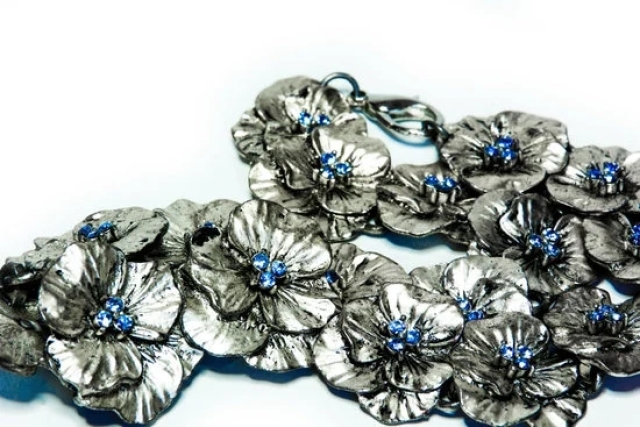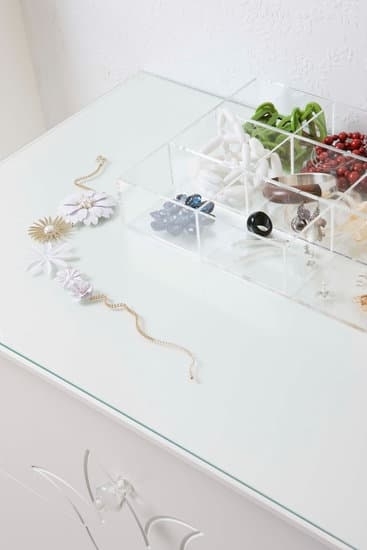Platinum is often referenced in regards to jewelry making and has been viewed as the standard for exquisite fine jewelry for many centuries. Platinum’s popularity over the years has only increased, becoming one of the most desired metals for contemporary jewelry designs.
While platinum may seem like a dream material for any jeweler, there are still some misconceptions around its use. In this article, we will explore some of these myths and reveal why platinum is the perfect metal for many jewelry styles.
Myth 1: Platinum Isn’t Durable Enough One of the most common myths surrounding platinum is that it is not durable enough to stand up to everyday wear and tear; however, nothing could be further from the truth. Platinum is actually one of the strongest precious metals available and survives even through challenging conditions such as scratches, bangs or denting.
Not only does it hold up properly in terms of wear and tear, but its density also makes it a strong metal when put under pressure as well – making it ideal for settings with a lot of diamonds or other precious stones which need high support.
Myth 2: Platinum Is Too Expensive To Use Another common myth people have about platinum relates to its cost compared to other materials used in crafting jewelry. Indeed, the market price for this precious metal fluctuates often but overall it remains a reliable option that can fit within a budget when working with limited funds – as long as you source your supplies from responsible suppliers.
It’s tough too; unlike some metals such as gold which require re-plating over time due to tarnishing, platinum won’t require regular maintenance since an occasional cleaning will suffice to keep it looking good as new.
Conclusion To sum up, while there are some misunderstandings around using platinum in jewelry making, by taking some time researching cottations and sourcing suppliers you can easily find affordably priced options while feeling safe knowing that it won’t degrade with time like other materials out there tend to do.
After all, having something that lasts through generations never goes out of style so it seems only natural that one should choose wisely when deciding what metal should their next design feature.
Overview of the Properties and Benefits of Platinum
Platinum is a valuable metal that is used in many different ways, but particularly in jewelry making. It has many excellent properties, making it an ideal choice for jewelers to craft beautiful necklaces, rings, earrings, and other pieces of jewelry. The following outlines some of the key benefits of platinum:
- Longevity: Platinum does not corrode easily and retains its luster over time. This makes it an ideal material for jewelry that will last years with very little maintenance.
- High Durability: Platinum is much more resistant to scratching than other metals used in jewelry making. This makes it better suited for everyday wear when compared to soft metals like gold.
- Hypoallergenic: Since platinum is composed of pure metal atoms without other contaminants or impurities often found in gold or silver, it is safe for people with sensitive skin who are concerned about allergies caused by jewelry.
Platinum also stands out as a very versatile material when crafting fine pieces of jewelry and can be designed into various intricate patterns and designs. This is because jewelers can work with the softer kind of platinum (pt 900) which allows them to shape the metal into whatever desired shapes using traditional tools such as hammers and casting molds.
Furthermore, aspiring jewelers can use various techniques like engraving, polishing or surface finishing to create interesting textures on their platinum pieces. Thus this malleable nature makes platinum jewellery remarkable versatile and able to fit any fashionable ensemble with ease.
Not only does this versatility make platinum popular amongst jewelers but additionally offers one major benefit – strength. Weight for weight, Platinum has greater tensile strength than either white gold or sterling silver thereby giving more durability against heavy wear while retaining a fine texture and sturdiness so one’s jewellery remains safe over the years despite rough handling.
Moreover since it requires minimal maintenance (often limited to rinsing off dirt), choosing this precious metal for your Jewellery can ensure peace of mind from having to worry about wearing them down with regular cleaning routines that may damage their fragile details along the way.
What Types of Jewelry Can Be Made Out of Platinum?
Platinum is an extremely strong, versatile and durable precious metal which makes it the ideal material to create beautiful pieces of jewelry. From necklaces and earrings to rings and bracelets, platinum can be used to craft stunning pieces of jewelry for any occasion. It’s also hypoallergenic, so it won’t irritate those with sensitive skin. Here are some of the most popular types of jewelry that can be made out of platinum:
- Rings
- Necklaces
- Bracelets
- Earrings
- Cuffs
- Ankle Chains
In addition to classic designs, custom-made pieces such as signet rings or family crests can also be crafted out of platinum. With the help of a skilled jeweler these complex designs can truly come alive in platinum. Even traditional engagement rings set with diamonds tend to look even better when encased in a beautiful platinum setting. The unique blend of cool tones make for a timelessly romantic choice.
When crafting jewelry from platinum, it is important consider its durability since this type of metal is relatively soft compared to gold or silver which makes it easier to shape into more intricate designs. However this also means that customizations should always be made by an experienced professional since without care platinum might become damaged from accidental scratches or other types wear and tear over time.
To prolong the life span of any piece created in this precious metal it should regularly be polished and cleaned using special cleaning solutions specifically designed for use on this type of metal.
Examining the Cost of Using Platinum for Jewelry Making
Platinum is a precious metal which has been used for making jewelry since ancient Egypt. It is prized for its purity, rarity, and longevity when cared for properly. Despite its price, platinum remains popular in the jewelry industry due to the beauty of its finish.
To understand why platinum is such an expensive material, one must consider its characteristics. Platinum is incredibly dense and heavy, giving it both strength and durability. It will not tarnish or corrode like other metals such as gold or silver. Additionally, due to the difficulty of extracting it from ore in comparison to other metals, platinum can be extremely difficult to come by.
The cost for using platinum for jewelry making can vary depending on multiple factors – some of which are listed below:
Factors Affecting the Cost of Using Platinum for Jewelry Making
- Purity – The higher the purity of pure platinum used means a higher cost.
- Craftsmanship – Specialized skill sets may result in higher craftsmen fees.
- Design – Complex designs often require specialized equipment resulting in higher costs.
- Availability – The easier it is to find pure platinum will cause the price to go down.
Working with Platinum
The unique properties of platinum make it a luxurious and desirable metal for jewelry making. This sought-after metal is malleable and ductile, which makes it easier to form into intricate shapes. Platinum is also hypoallergenic, resistant to tarnish, and more durable than gold or silver; all of which make it an ideal choice for high-end pieces of jewelry that have a timeless quality.
Finding the Right Supplier
If you are interested in working with platinum, you’ll first need to find a reliable supplier. A reputable dealer will offer only pure precious metals and should be willing to provide a certificate of authenticity or purity test results for each product they sell. Working with a reliable supplier ensures that your materials are genuine and safe to use when crafting jewelry pieces.
Safety Tips When Working With Platinum
When crafting pieces from platinum it’s important to take safety precautions at all times. To prevent any accidents involving the metal, use eye protection during the fabrication process, keep tools and machinery properly maintained, wear gloves with grip protection while handling hot metals, and use proper ventilation at all times.
Additionally, it’s also essential that adequate lighting is available so you can clearly see what you’re doing while forming or soldering the platinum pieces together – preventing any mistakes occurring along the way.
Cleaning Platinum Jewelry Pieces
After creating your piece of jewelry from pure platinum there will commonly be some residue left behind such as polishing compound or oxidation created by heat generated when working on the piece. A soft brush can used in combination with water or alcohol to remove most residual material without leaving scratches on the finished jewelry item.
For any stubborn residues that won’t brush away easily then use white toothpaste which does an excellent job at removing these stubborn materials without damaging your new creation in any way.
Common Challenges When Working with Platinum for Jewelry Making
Platinum is a highly sought after precious metal due to its rarity and price point. But it can be tricky to work with due to its strong properties and difficulty in soldering. Here are some of the most common challenges when working with platinum in jewelry making:
- 1. Low Malleability: Platinum is very strong, which makes it hard to cut, shape and stretch without cracking.
- 2. High Melting Point: Platinum has an incredibly high melting point of 3262°F (1800°C) making soldering with other metals difficult.
- 3. Difficult Welding: Platinum’s hardness requires special welding techniques such as casting or brazing.
Despite the difficulties in working with platinum, craftspeople persist because they appreciate what platinum adds to their designs in terms of elegance, durability and luster. The effort required for creating jewelry out of this precious metal is worth the effort when you see the finished product at work.
Nowadays, there’s access to advanced equipment that offers even more accuracy in cutting and shaping which makes working with platinum much easier than before – allowing craftspeople to make intricate pieces with relative ease if they have the right tools and techniques for doing so.
Nevertheless, some basic tasks like filing and sanding still remain challenging due to how quickly files can get clogged up or how unevenly sandpaper wears off when attempting to smooth out edges that have been worked on extensively by sawing or filing.
To resolve this issue while ensuring a smoother finish, experienced professionals opt for diamond-coated tools such as diamond burrs or diamond polishers that are specially designed for working on harder materials like platinum – saving time and money during production processes.
Comparing the Pros and Cons of Making Jewelry Out of Platinum
Platinum is a metal that is often used to make jewelry. Although it can be expensive, it has many positive features and advantages that make it an ideal material for making jewelry. Here we’ll take a closer look at how Platinum compares with other materials when it comes to creating beautiful pieces of jewelry.
Pros
- Platinum is very durable and does not easily tarnish
- It’s hypoallergenic so it won’t irritate sensitive skin types
- Its superior strength allows for detailed designs, intricate shapes and thin walls in jewelry, while still providing excellent wear resistance
- Works well with polished stones or gems
Cons
- Cost – Platinum is more expensive than most other metals used for making jewelry.
- Difficult to shape – Platinum is very hard to work with compared to gold and silver. It requires skilled craftsmanship.
- Excessive weight may not be desirable – If you are looking for lightweight pieces of jewelry, platinum might not be the best option.
Color Variations
One of the main differences between platinum and other metals is that platinum does not come in a variety of colors the way gold and silver do. The lack of color variation means that if you’re going for a specific colored piece of jewelry that would look better in rose gold or yellow gold than platinum wouldn’t be the best choice.
Conclusion
In conclusion, as to whether or not it is worth investing in platinum for jewelry making really depends on the individual and their individual needs. Platinum has become increasingly popular for jewelry making due to its luxurious appearance, durability, and hypoallergenic properties. It is generally more valuable than other metals such as gold and silver due to its rarity and ability to hold a higher luster.
This can make it an excellent option for those looking to create high-end pieces that can last a lifetime. On the other hand, it may not be the best investment for someone looking for something more affordable and temporarily fashionable. Its relatively expensive cost when compared to other metals can deter some buyers from investing in platinum.
Ultimately, if you are looking for your jewelry pieces to have longevity, unsurpassed beauty, and exceptional craftsmanship; then investing in platinum could be well worth it. As its rarity increases year over year, having a piece of jewelry made with this distinguished metal could prove beneficial both financially and aesthetically.
To ensure you get the most out of your investment it might be necessary to do some research into reputable jewelers who specialize in this metal or who use the highest quality of materials in their products.
Additionally, many reputable sellers offer a guarantee on their products so shoppers should read thoroughly before committing. With an array of designs available certified jewellers should be able to provide customers with elements that fulfill particular values like beauty and craftsmanship all within their desired budget bracket.
Overall then investing in platinum for jewelry making could equate to an ideal purchase given its luxuriousness, cost effective nature over time and ability to stand up against day-to-day wear without losing any value whatsoever – sure signs that it could indeed be worth its weight in gold.

Welcome to my jewelry blog! My name is Sarah and I am the owner of this blog.
I love making jewelry and sharing my creations with others.
So whether you’re someone who loves wearing jewelry yourself or simply enjoys learning about it, be sure to check out my blog for insightful posts on everything related to this exciting topic!





